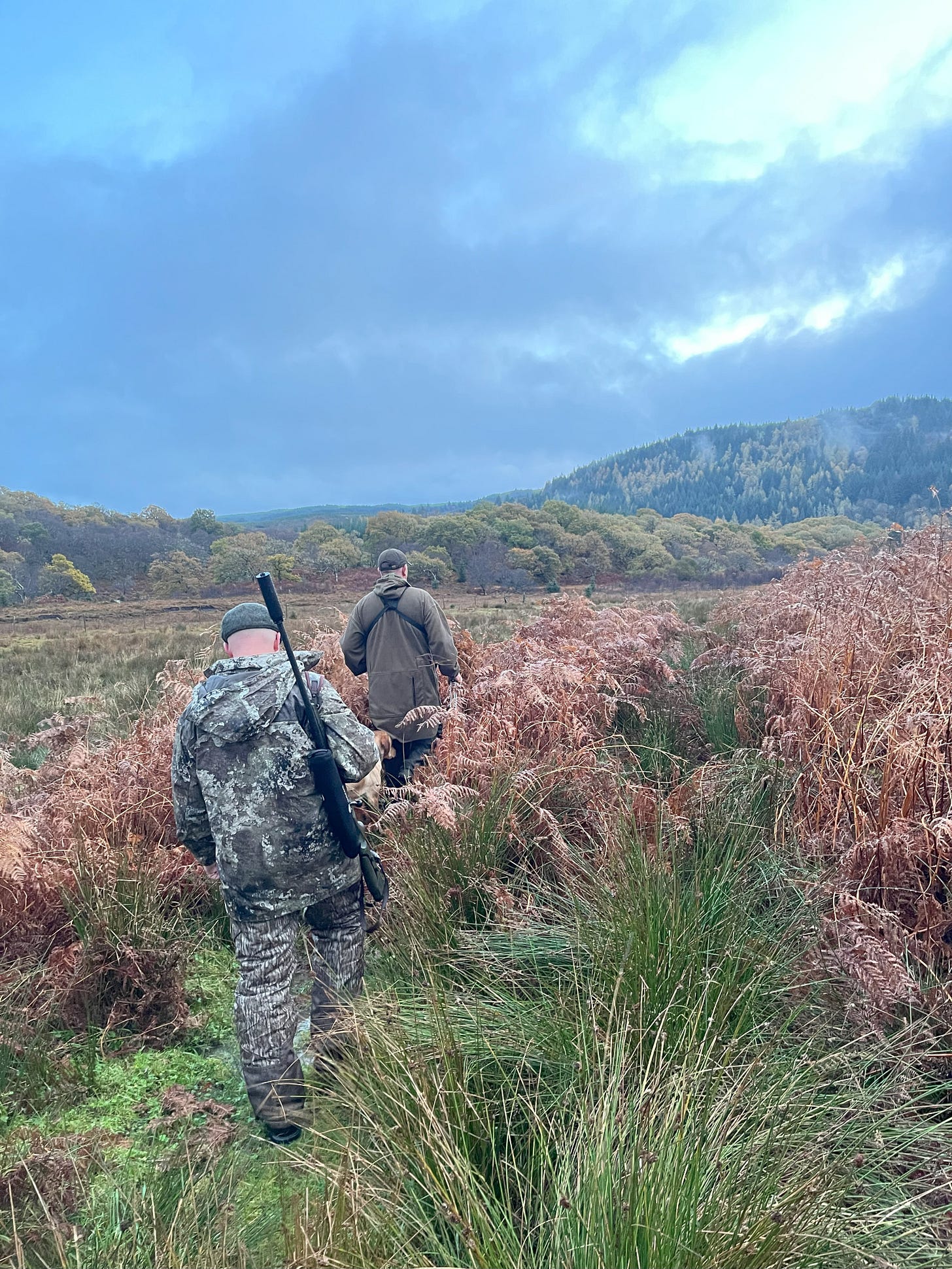Stalking through time
Deerstalking amid Neolithic monuments
An old friend of mine, A———, came over for a flying visit this past month.
The highlight of the trip was a midweek stalking trip in mid-Argyll, Scotland, outside a town called Kilmartin,
Place names are fascinating in any country. But here in Scotland, history is often written plain as day in the names of towns and villages. Any town with “kil” at the beginning likely has reference to old monastic “cells.” Thus, Kilmartin, Kilmarnock, Kilmacolm, etc. all have references to an ancient religious past, buried right in the name.
But Kilmartin stands out even among those. There’s an ancient medieval church there to be sure. But Kilmartin’s history stretches back far, far further than medieval times. The town sits on the side of a small valley. In a nearly straight line running through the center of the valley are four stone age cairns - large mounds of stone, burial sites for important figures in a world so far removed from ours that even any hint of a name is long, long gone.
Deep time, you might say.
Nor are the cairns the only thing in Kilmartin. Several stone circles exist, with dozens of other monuments of various kinds scattered throughout the area. In fact, Kilmartin Glen boasts one of the highest concentrations of prehistoric sites in the UK, and by far and away the highest in Scotland.
So when A—- settled on that area for a stalk, I was thrilled. This gave a chance to see some incredible sites coupled with the traditional UK morning-and-evening stalk.
The morning stalk took us through some forest above Kilmartin. Successful stalk on a red hind, and sightings of several impressive stags.
But while the morning stalk was both fun and impressive, it was the afternoon that left the greatest impression.
Between outings, we ate at the local inn and wandered the glen itself. Just standing next to some of those sites is enough to trigger something. A——- calls it genetic memory; I tend to think that the presence of so many souls, for so long, in one place, leaves a mark. “Deep calls to deep,” and within man’s soul, something responds.
After a short rest, we were off again. Our guide, Rab, took us a parcel of land a short distance up the glen. I dozed in a car (a weakness), and awoke to find us arrived at the end of a farm track.
After gearing up for the classic Scottish downpour, we were off.
The parcel was what is classed in the UK as “ancient woodland”, parcels of trees and forest that have been largely undisturbed since before the United States became a country. In this case, a low ridge was covered in mossy oak trees. It being October, and a mast year here, the ground was amply carpeted in acorns. A few cows grazed here, keeping vegetation in the woods less dense than it otherwise would have been.
The result was some of the prettiest country I have had the privilege of wandering. And the best part was yet to come.
Following the ridge in the hope of disturbing any resting reds, we reached an overlook. Below was a wide stretch of moorland and moss bog which Rab referred to as “the moss.” Beyond, looming over the moss, stood a rocky outcrop that I recognised instantly.
Dunadd. Ancient capital and stronghold of the Kingdom of Dalriada, early Christian kingdom of the Middle Ages. Dalriada held sway over a vast stretch of coastal western Scotland, the islands between Scotland and Ireland, and parts of Ireland itself. Kingdoms of that time seemed to prefer capitals perched on easily defensible rocks; one of Dalriada’s competitors was the Kingdom of Strathclyde, centered on Dumbarton Rock (my local castle).
And here we were, stalking through the mists on a rainy Scottish afternoon, stalking the same native red deer, in the same area, that men had done a thousand years earlier.
That will get any man’s blood singing.
The older I get, the more mystical I become. That’s in part because I think mystery and mysticism are things our modern culture largely despises, and there’s value in recovering that awareness.
But also, as men in a modern age, we would do well to embrace the humility that mysticism properly brings.
The kingdom of Dalriada, like the kingdom of Strathclyde and other pre-Scottish kingdoms, was almost certainly Christian. Believers worshipped there on that grey rock, monastic sites proliferated throughout the area, and missionaries travelled through regularly.
Here I was, a Christian over a millennia later, retracing those same footsteps.
Truly there is nothing new under the sun, or under the gloomy, moody Scottish autumn rains.
Action Points:
Get outside. I don’t care what you do, but pick an outdoor activity you enjoy and stick to it. Fresh air will do wonders for your mental health.
Be humble. You are not the first man on the moon; in all likelihood, every path you take, someone else will have trod. Seek out the lesser paths, but let an awareness of history keep you meek.
Bonus: Read Ecclesiastes. The book is packed with woe, frustration, and an odd sense of hope. It’s also the perfect antidote to today’s materialistic, gotta-get-it-all attitude.
Till next time.




